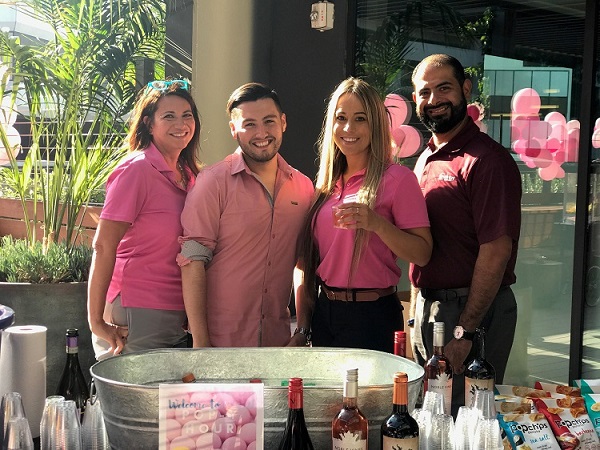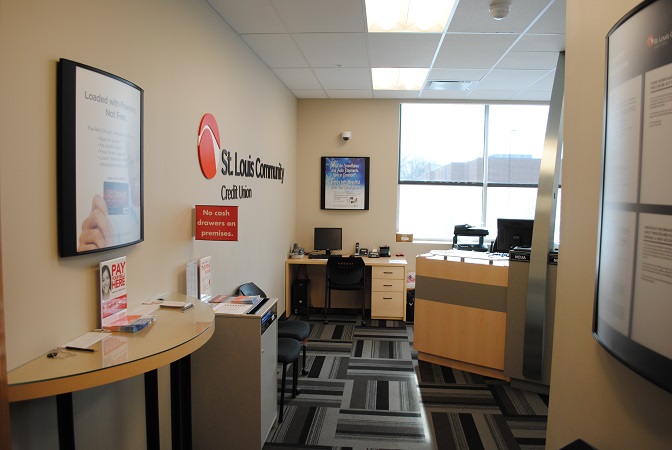Top-Level Takeaways
-
Across credit union land, cooperatives are going their own way on location, designs, and partnerships.
-
Linkups with coffee shops, DMVs, and social service sites are just a few examples. So, why not a pub?
Credit unions across the land working to stay relevant and differentiate themselves from the competition are innovating on perhaps their most venerable physical asset the branch.
Member-owned cooperatives have long been a mainstay in SEG workplaces, grocery stores, and large retailers. Now, to continue meeting members where they live, some credit unions are sharing space with heavily trafficked partners like coffee shops and license bureaus. Some are popping up inside social service agencies that share their mission. And some are simply just popping up.’
Here, six credit unions from California to Connecticut, northwest Washington to southwest Louisiana and up to St. Louis share their strategies for branching success.
O Bee Taps The Market With Pub-Style Branches

Lee Wojnar, Vice President of Marketing, O Bee Credit Union
O Bee Credit Union ($322.4M, Tumwater, WA) is going back to its roots while serving up a pub-style banking experience. The Olympia-based credit union was founded in 1955 by an employee of the former Olympia Brewing Company, which operated in Tumwater from 1896 to 2003. Now, membership to the credit union is open to anyone who lives in Washington state.
The brewery produced popular brands such as Rainier, Pabst, and Olympia. O Bee Credit Union has recently remodeled three of its eight branches recently to reflect that past and plans to remodel a fourth. According to Lee Wojnar, vice president of marketing at O Bee, the branches offer an immersive experience.
With the onslaught of technology, other financial institutions are struggling to distinguish themselves in the marketplace, Wojnar says. We took a different approach by inviting people back into branches.
The teller lines feature local beer taps, brass railings, and frosted glass partitions, and each branch features signage particular to its location. There are also beer barrels, branded burlap bags, old-school neon lighting, and chalkboards that display specials.
O Bee’s Beery Branch And Marketing Concepts
- ‘
- ‘
- ‘

No, the beer taps don’t work, but the tellers who staff the line at O Bee’s brewery-themed branch sure do.
‘
‘

The Point Ruston branch entrance bears the credit union’s neon moniker, which looks very much like a bar sign.
‘
‘

O Bee sends new members a tri-fold post card that shares the credit union’s history, including which SEG beer hit it big in Hollywood and cards that carry the logos of beers brewed by past O Bee members.
Click here to view the full image.
It’s like you walked into a local pub, Wojnar says. The reaction has been outstanding. We’re attracting a younger generation of members who don’t traditionally visit branches.’
There’s also a community development angle to O Bee’s pub banking bid.’
We’re opportunistic and revived former bank branches at minimal cost, Wojnar says. We’re determined to serve communities that don’t have access to a credit union.
South Bay Pops Up In Shared Spaces’

Jennifer Oliver, President and CEO, South Bay Credit Union
South Bay Credit Union ($109.9M, Redondo Beach, CA) has placed two pop-up branches inside shared office spaces that are proliferating in that part of suburban Los Angeles.
After visiting a shared-office operation, South Bay president and CEO Jennifer Oliver asked her board in June 2018 to spend $8,750 to move forward with a proof-of-concept pop-up branch. The executive says the concept is a low-risk way to reach millennials and other tech-savvy and entrepreneurial types who co-work around the aerospace-heavy South Bay area.
We don’t own anything; we are not under a term contract, the executive says. They supply furniture, utilities, and high-speed internet. They put our logo on the door. We show up with our people and computers.
The first office operated for nine months in Cross Campus South Bay. A relationship manager staffed the branch and was often joined by a marketing coordinator who was there to learn, watch, and support, Oliver says.
South Bay’s Shared Office Work
- ‘
- ‘
- ‘

Cheery greetings at South Bay’s pop-up branch located inside a shared office space invited visitors to pop in and chat about finances or whatever else was on their mind.
‘
‘

The South Bay Cross Campus building housed the first pop-up branch from South Bay Credit Union.
‘
‘
‘
‘
‘
‘
‘

Social time is a major feature of many shared office spaces. South Bay Credit Union celebrated the opening of its pop-up branch with Pop-y Hour. Shown here from left are president/CEO Jennifer Oliver, relationship manager Cesar Reynoso, marketing coordinator Heather Steele, and vice president of risk management Frank Espinosa.
That branch closed in April. Now, the credit union is four months into its second pop-up branch, this one at a co-working site called Spaces.’
We took the learnings from our first one to our second one to see how we could tweak things to make us more appealing, Oliver says.
In the pop-up model, South Bay emphasizes business development and new memberships. The model also allows South Bay to fine-tune its delivery of digital services.’
We’re practicing using our remote delivery options, seeing how they’re adopted and tweaking things along the way, Oliver says. That’s very cool.
Up next for South Bay? A branch on wheels, which will allow the credit union to pop anywhere. Oliver says, given the South Bay vibe, she’d like to adapt a Volkswagen minibus, but there’s one hitch. Seems like no one can drive a stick shift, she says.
Share and Download Resources
Find the Board Action Request that Oliver presented to her directors for approval of the pop-up branch projects and a wide variety of documents, policies, and workable templates in Callahan’s Policy Exchange. Pull these credit union donated documents off the shelf and tailor them to your needs.

Louisiana Credit Union Partners With Health Clinic In Banking Desert

Jessica LaRocca, Chief Strategy Officer, Southwest Louisiana Credit Union
At this time next year, Southwest Louisiana Credit Union ($105.5M, Lake Charles, LA) should have its newest branch open inside a public health clinic that serves an area that’s also a bit of a banking desert.
The partnership came about after Patricia Prudhomme, business development director for SWLA Center for Health, approached Southwest Louisiana’s chief strategy officer Jessica LaRocca after a community development summit LaRocca had organized.’
She expressed how financial health also affects their patients and asked if we would be interested in having a micro-branch in their facilities, LaRocca says. They would do the build-out and not charge us a lease. They have land available if we want to build a larger branch later.’
That was an offer too good to refuse, both financially and strategically. The new branch will give Southwest Louisiana a presence in north Lake Charles, an area it otherwise would be leaving behind when it relocates its main office to the southeast side of town.
According to LaRocca, a small Chase branch is the only other financial institution in north Lake Charles.
By piloting a microbranch there, we’ll be meeting the needs of an underserved market that faces multiple issues around transportation, hunger, health, low income, and lack of savings, LaRocca says.’
All of Southwest Louisiana’s staff are Certified Credit Union Financial Counselors. The credit union expects to open the branch by next fall and will staff it with one employee and a full-service kiosk for operation during clinic hours.
We’re looking forward to helping financially empower the north Lake Charles community, LaRocca says.
Nutmeg State Spices Up Branch With DMV’

John Holt, President and CEO, Nutmeg State Financial Credit Union
When AAA bowed out,Nutmeg State Financial Credit Union ($460.2M, Rocky Hill, CT) stepped up, putting in a winning bid to host licensing services for the Connecticut Department of Motor Vehicles.
The first shared-services branch opened in June 2018 in Milford and the second in December in North Haven. Both are new facilities designed as shared-service spaces and both use self-service technology to keep the traffic flowing.’
Any Connecticut resident can visit us to renew or replace their licenses with wait times averaging under 15 minutes, John Holt, president and CEO of Nutmeg State. Our banking kiosks offer a range of self-service opportunities, but members can still ask any of our on-site staff for help.
The credit union charges an $8 fee to non-members who want to use the DMV Express services. However, it waives the fee if they join the cooperative. More than 48,000 people have used the DMV services during the first 20 months of combined business across the two branches.’
Nutmeg State’s Co-Location With The Connecticut Department Of Motor Vehicles
- ‘
- ‘
- ‘

Nutmeg State has co-branded two storefront locations with the Connecticut Department of Motor Vehicles.
‘
‘
‘

Connecticut drivers can renew and replace licenses in the DMV Express section of the shared space.
‘

The Nutmeg section is the credit union’s first use of full self-service technology that allows members to apply for loans and cards, transfer funds, make loan payments, and deposit and withdraw cash.
In fact, it’s the exposure, not the fee income, that attracted the credit union, which is battling declining branch traffic in its traditional locations.’
Our main reason for partnering with the DMV was for non-traditional foot traffic, Holt says. Our new member growth has increased substantially, and we’ve been busy introducing new members to our services.
The credit union is prepared to immediately make the most of its expanded reach.
My biggest piece of advice would be to ensure you have the ability to access the right data to effectively market to non-members who come through the door, Holt says. Ultimately you want to create an Amazon-like experience with a predictability model that enables you to capture the business at the first point of contact.
St. Louis Community Sets Up At Social Services Sites

Paul Woodruff, Vice President of Community Development, St. Louis Community Credit Union
St. Louis Community Credit Union ($299.5M, St. Louis, MO) has been embedding branches within social service agencies since 2011. The reason is simple.
We meet people where they are, says Paul Woodruff, the credit union’s vice president of community development. We find ways to overcome issues of mistrust with populations who have been marginalized or ignored by the mainstream banking sector.
SLCCU has mini-branches placed inside the Metropolitan Education and Training Center, Grace Hill Settlement House, and Kingdom House, now known as LifeWise STL. The three sites host a range of community services and classes, ranging from food assistance to vocational training and traditional community college offerings.
The mini-branches make a lot of mini-loans, small in size but critical to the borrowers. Members use the average disbursements of $2,500 to $3,600 typically to purchase used cars, build credit, or avoid payday lenders
St. Louis Community’s Mini-Branches Inside Social Service Sites
- ‘
- ‘
- ‘

SLCCU’s branch in Metropolitan Employment Training Center serves students who attend community college and vocational training classes in the St. Louis County facility.

SLCCU also has a nontraditional branch inside the Grace Hill Settlement House, which hosts programs like Head Start for children and Connections to Success for adult employment training.

Staffers discuss products, services, and financial empowerment with members who visit the credit union’s three agency-housed mini-branches. This photo is from the LifeWise STL location.
Woodruff says the credit union considers each of the branches full-service, with the same offerings as the credit union’s other dozen or so sites. In eight years, Grace Hill has opened 2,050 accounts and made 1,232 loans for nearly $3.2 million, and the MET Center has opened 1,834 accounts and made 985 loans for nearly $3.6 million. In seven years, the LifeWise STL site has opened 711 new accounts and made 556 loans for just under $1.8 million.’
That’s not really a lot of activity for a credit union with 17 branches, more than 61,000 members, and a loan portfolio of $171.6 million, but that’s not the point.
Our mini-branches are not intended to sustain our business, Woodruff says. They exist to provide access to folks who don’t live near financial service providers or who might be leery of mainstream financial services.’
Canopy Brews Business With Spokane Coffee Shop

Charlotte Nemec, President and CEO, Canopy Credit Union
There’ll be nothing but a sliding glass door between coffee and cooperative when Canopy Credit Union ($161.3M, Spokane, WA) opens its newest branch this fall.’
The branch will be located in the Spokane Valley, a suburb to which both Canopy and Revel 77 Coffee wanted to expand. The branch will offer drive-up and interior ITMs as well as member advocates and financial coaches. The coffee shop will offer well, coffee and light food.
They’ll share the same modern look and feel, with clean lines of wood and metal and furnishings that will make visitors want to hang around for a while.
We’ve always had a nice coffee and treat bar in our lobby, says Charlotte Nemec, president and CEO of Canopy. When we bought this property and decided we would lease out a portion of it, we knew we wanted to make it a place where people would come in, relax, and enjoy time alone or with friends.’
According to Nemec, the credit union has invested $1.8 million in the project, which included buying and clearing the lot and erecting the new building at one of the busiest corners in town.’
Artist’s Renderings Of Canopy’s Branch/Coffee Shop Shared Space
- ‘
- ‘
- ‘

Canopy Credit Union and a local coffee shop in Spokane, WA, will share a roof and floor space when construction is completed this fall.

An artist’s rendering of the new branch shows how Canopy is designing space for conversations more than transactions.

A sliding glass wall, which will be rolled back when the branch is open, is all that will separate Revel 77 Coffee from its credit union companion.
Although the two enterprises will share a roof, not everything will be equal. Nemec says Canopy will occupy 2,105 square feet of the 3,385-square-foot building, adhering to NCUA requirements that a credit union occupy at least 50% of the space it owns. Also, the coffee shop will have longer hours, thus the need for the sliding glass door.’
But the relationship will still be symbiotic.’
We’ve always loved supporting local businesses, so this strategy fulfills two strategies supporting Revel 77 Coffee while creating a steady stream of traffic that will allow us to show off how fun, cool, and appealing we are, Nemec says. We’ll be getting warm leads all day long.
